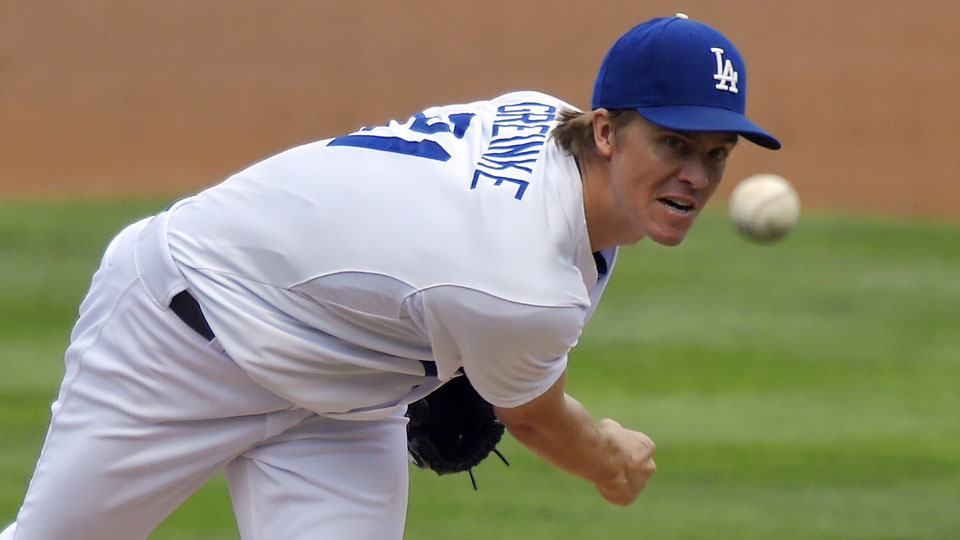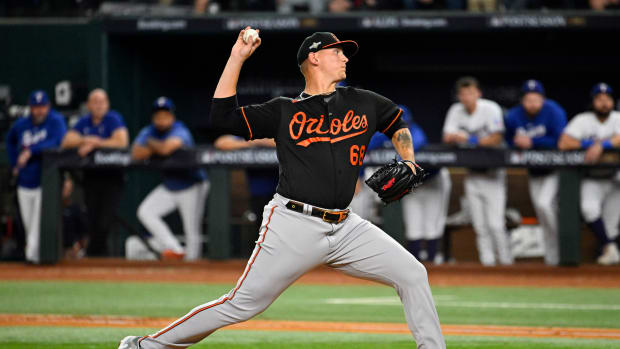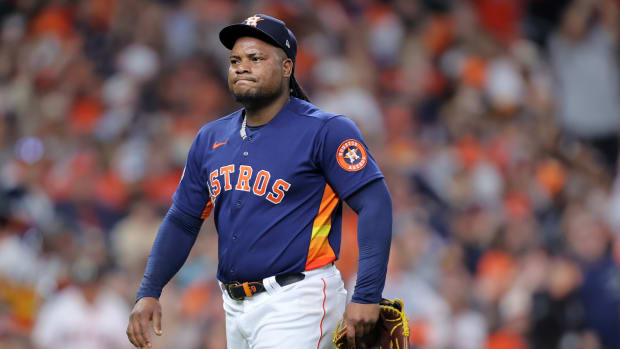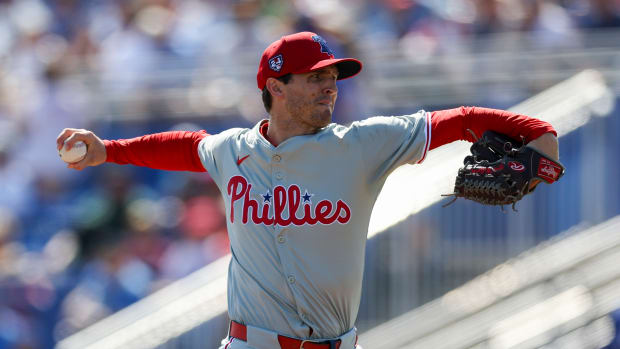NLDS Game 2: Dodgers need a win to get back on track vs. Cardinals
Start Time: 9:37 p.m. ET
TV: MLB Network
Starting Pitchers:Lance Lynn (15-10, 2.74 ERA) vs. Zack Greinke (17-8, 2.71 ERA)
Few could have seen the series-opening Clayton Kershaw-Adam Wainwright pairing turning into a 19-run slugfest, but unseasonably hot temperatures at Chavez Ravine on Friday gave the ball some extra carry and led both pitchers to melt down at inopportune times. But whatever the score, the fact remains that the Cardinals seized a 1-0 series lead from the road, making Game 2 nearly a must-win for the Dodgers before the series heads to St. Louis.
Holliday, Cardinals chase Kershaw to take 1-0 NLDS lead over Dodgers
• CORCORAN: Previewing Nationals-Giants NLDS Game 2
For this game, both teams send to the mound pitchers whose strong seasons tend to get lost in the shadows of their more famous teammates. As I pointed out in my preview, Greinke joined Kershaw as part of the majors' only rotation tandem with an ERA below 3.00 and more than a strikeout per inning. The 30-year-old righty whiffed 9.2 per nine (good for fifth in the league) while walking just 1.8 en route to a 4.8 strikeout-to-walk ratio (6th in the league). Meanwhile, his 48.7 percent groundball rate was the second-highest of his career, helping him limit home runs (0.8 per nine). In all, his 4.3 WAR was his best season since his 2009 AL Cy Young-winning campaign.
Here's what BrooksBaseball.net had to say about his arsenal:
In 2014, he has relied primarily on his Fourseam Fastball (93mph) and Sinker (93mph), also mixing in a Slider (86mph), Change (88mph) and Curve (73mph).
…His fourseam fastball has much less armside movement than typical, generates more whiffs/swing compared to other pitchers' fourseamers and has essentially average velo. His sinker has surprisingly little armside run, has little sinking action compared to a true sinker and results in somewhat more groundballs compared to other pitchers' sinkers. His slider is a real worm killer that generates an extreme number of groundballs compared to other pitchers' sliders and has short glove-side cut. His change… generates an extreme number of groundballs compared to other pitchers' changeups, is much firmer than usual and has some natural sink to it. His curve comes in below hitting speed, generates fewer whiffs/swing compared to other pitchers' curves, has a sharp downward bite and has slight glove-side movement.
This year, Greinke showed a very out-of-character reverse platoon split that mainly manifested itself in the power department (.248/.290/.399 against righties, .246/.283/.344 against lefties). Last year the story was much different, as he stifled righties (.216/.262/.306) while getting knocked around by lefties (.254/.322/.410). In Matt Adams, Matt Carpenter and Jon Jay, the Cardinals have three key left-handed contributors; all three managed at least a .349 OBP against righties, but Adams (.318/.349/.505) was the only one of them to slug at least .400 against them. In Game 1, that trio combined for five hits, including two big extra-base hits for Carpenter.
The road to a title — or not — for every Division Series team
• Complete postseason schedule, start times and TV listings
To the extent that matchup stats mean anything, it perhaps bears noting that Grienke does have long-ish histories (32 PA or more) with four St. Louis regulars; Jhonny Peralta has hit just .229/.327/.292 against him in 55 PA, and Jay has struggled against him but Matt Holliday and Yadier Molina have fared well. Greinke handled the Cardinals in last year's LCS, allowing four runs with a 14/2 strikeout-to-walk ratio in 15 innings over two starts. He made two starts against them in a three-week span, whiffing 10 while allowing one run in seven innings at Dodger Stadium on June 28, and struggling with his control in a 5-walk, 4-run start over 5 2/3 innings in St. Louis on July 19.
As for Lynn, despite similar peripherals from year to year, he set a career bests in ERA, innings (203 2/3) and WAR (3.7) in 2014 thanks in part to a .293 BABIP, down from above .320 in each of the past two seasons; via that, he delivered a quality start in 73 percent of his turns, a rate that ranked ninth in the league. While his FIP was virtually identical from half to half (3.34 to 3.36), he put up a 2.22 ERA after the All-Star break, compared to 3.14 before, aided by a falling BABIP.
Here's how BrooksBaseball.net sees his repertoire:
In 2014, he has relied primarily on his Fourseam Fastball (94mph) and Sinker (92mph), also mixing in a Cutter (89mph) and Curve (80mph).
...His fourseam fastball generates a high number of swings & misses compared to other pitchers' fourseamers, has some natural sinking action, has essentially average velo and results in somewhat more flyballs compared to other pitchers' fourseamers. His sinker is a real worm killer that generates an extreme number of groundballs compared to other pitchers' sinkers and has some natural sinking action. His cutter is a real worm killer that generates an extreme number of groundballs compared to other pitchers' cutters, has little cutting action and has some natural sink. His curve generates fewer whiffs/swing compared to other pitchers' curves, is slightly harder than usual and results in somewhat more groundballs compared to other pitchers' curves.
Lynn has a fairly typical platoon split (.234/.293/.342 against righties, .244/.325/.372 against lefties), which could help a bit as the larger share of the Dodgers' weapons — Matt Kemp, Yasiel Puig, Hanley Ramirez and Juan Uribe — are righties. That said, the team tagged righty pitching (.271/.334/.412) en route to the second-highest OPS in the league, and the aforementioned quartet accounted for six of the 11 hits off Wainwright; meanwhile, the team hit just .248/.329/.387 against lefties.
Lynn doesn't have a particularly long history against any of these Dodgers. He was chased after two innings and seven runs allowed in a start at Dodger Stadium on June 28, but recovered to throw six solid frames in St. Louis on July 18, striking out nine. He made two appearances in last year's NLCS, tossing two innings of relief in the marathon Game 1 and 5 1/3 innings of two-run ball in Game 4.
• WATCH: Will Yost manage Royals out of the postseason?
As for the bullpens, by leaving Kershaw in, only to watch rookie Pedro Baez serve up a game-breaking three-run homer by Holliday, Dodgers manager Don Mattingly basically conceded what everybody knew: the bridge from his starters to closer Kenley Jansen is perilous. Dodgers relievers ranked 12th in the league in ERA (3.76) and 14th in strikeout-to-walk ratio (2.2), and so in assembling his series roster, Mattingly bet on the devil he didn't know (Baez, fellow rookie Carlos Frias, and Scott Elbert, the latter of whom threw just 4 1/3 major league innings this year) over the devil he did (Chris Perez, Roberto Hernandez). He still has only two relievers he fully trusts in Jansen and lefty J.P. Howell. Given that Greinke is one of the game's best hitting pitchers, batting .263/.336/.364 in 141 PA over the last two years, it goes doubly that Mattingly might try to stick with him longer than he otherwise might, to get an extra at-bat out of him as much as an extra out or three.
The Cardinals pen wasn't a whole lot more reliable during the season (3.62 ERA, 10th), and Friday night's contest offered reminders that Carlos Martinez and Trevor Rosenthal, so dazzling down the stretch for last year's pennant winners, endured sophomore slumps this year, the latter despite notching 45 saves (with six blown saves) due to a gaudy 5.4 walks per nine. That said, Martinez did put up a 1.71 ERA with strong peripherals in 19 appearances totaling 21 innings after returning from the minors in mid-August. In him,
Seth Maness and sidearmer Pat Neshek, manager Mike Matheny at least has a few more arms he can trust than his opposite number.



































